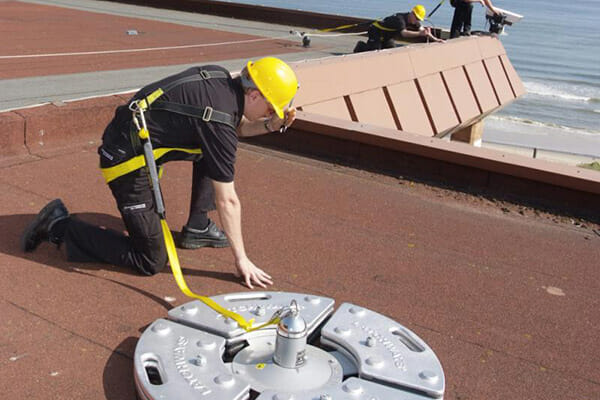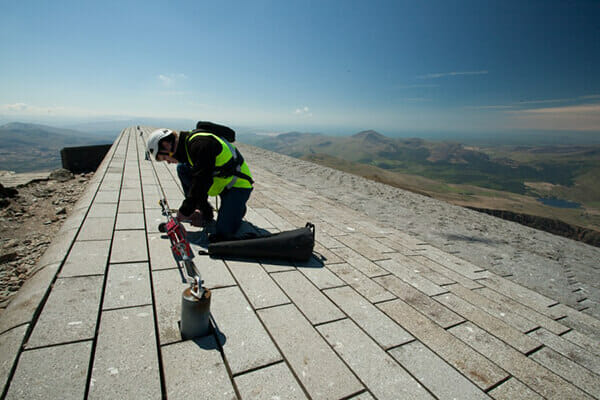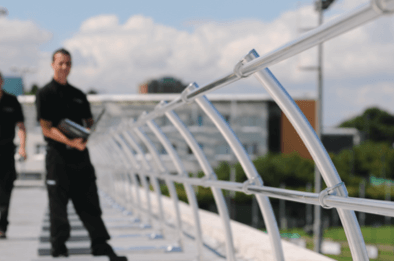Free Standing Handrail, what does the New BS 13700 mean for permanent roof guardrail installations?
The BS13700 standard was published in July 2021 and provides long-awaited guidance for the design, performance, testing and inspection of permanent counterweighted roof-top guardrail protection systems. This standard provides clarity for the design of these systems whilst addressing the concerns that many designers face when specifying this form of protection to buildings and structures.
Firstly, what is the benefit of handrail fall prevention systems & the installation of permanent roof guardrails? Allow us to explain the importance of understanding why these systems are specified & why the new standard has been introduced.
Why guardrails are the first choice for collective fall protection?
The HSE has a hierarchy of control regarding working at height protection, with the first choice being what is referred to as ‘collective’. This is where the person accessing works at height requires no form of training or PPE adjustment, they are protected without any other form of working at height equipment, such as harnesses and lanyards. This can be broken down as below,
- Avoid working at height
- Prevent falls using collective equipment
- Prevent falls using personal protective equipment
- Minimise distance using personal protective equipment
This isn’t always possible of course due to planning restrictions, or site restrictions where you may have no option but to install a cable based fall protection system. However, tread with caution because when you start looking at the different types of guardrails there are differing standards that need to be conformed to.
What sort of guardrail suits your requirements, free-standing, fixed, curved, inclined, collapsible?
So, which form of guardrail are you going to specify, what requires your consideration?
If you are looking to fully protect then you will require a permanent solution. Is the roof able to take the weight of the free-standing? Is the building structure capable of taking the loads required for a fixed solution? Are there planning constraints where you could use the collapsible? Are there planning constraints where you can set the handrail back from the roof edge and used curved, inclined, or radiused? Do you really not wish to penetrate the roof, hence the free-standing option? Penetrating the roof can bring headaches such as warranty issues, or even create a weak point on the roof regards water ingress.
A freestanding guardrail system is quick and easy to install, making this the ideal solution for retrofit projects. This is much less intrusive in regards to the occupants of a building.
What standards should your roof guardrail comply with?
Once the client, designer, and architect have decided upon which method is the best solution the next state is to ensure that it complies with the relevant standard. The roof edge protection was designed to comply with one of the standards below.
EN 13374 2004 Temporary edge protection systems.
Product specification, test methods (preceded by Temporary Systems – HSE Specialist Inspectors Report – Design Loadings for Temporary Roof & Floor Edge Protection (HSE/SIR 15 – 1988)
Permanent Systems – BS 6180: 1982 Protective Barriers in and about Buildings
Eurocode 1: Actions on Structures – Part 1-4: General Actions – Wind Loads
EN 14122-3 standard, which is intended for guardrails around plant and machinery
The issue was that there was never clear guidance on which standard should be followed. As an example, EN 13374 relates to temporary edge protection and does not specify the correct height of 1100mm for permanent guardrails. There was also the critical question of which standard was applicable to a system that was not physically connected to the building, i.e. the increasingly popular permanent counterweighted edge protection.
So, the NEW standard! BS 13700:2021
This new standard has been written specifically for manufactured permanent counterweighted guardrail systems that are not fixed directly to the roof’s structure and provide clear best practice guidance for those designing, testing, maintaining, and inspecting these types of systems, but what does the new standard mean to specifiers, installers, and the building owner?
The important points for BS 13700
For every installation carried out there is a requirement for site-specific wind speed calculations that conform to wind loading criteria set out in BS EN 1991-1-4:2005+A1:2010.
Installations must be designed according to the wind calculations in regard to the location, height of the building, and exposure level. Once the installation has been carried out you must have a system technical file as outlined in BS 7883:2019. This is produced by the designer and passed to the duty holder for the life of the system. The system technical file must be made available to anyone persons undertaking out the future inspections and maintenance of the system (s).
The revised guidelines state that annual inspection has to be carried out on permanently installed counterweighted guardrail and should be in line with the specific manufacturers’ recommended examination regime. To add to this, it is imperative that wind calculations are retrospectively applied to verify the systems wind design during the annual inspection.
Important note
For all permanent free-standing handrail systems that have been installed prior to July 2021, it is the responsibility of the building/premises owner, or the health & safety manager to have the system inspected. It is also a requirement that wind calculations are carried out to ensure that the original design complies with the new standards.
We hope that the above goes some way to provide an explanation to you regards these revised changes, but above all, you need to ensure that you are fully aware that evidence must now be provided regards the system design, wind calculations, and inspection regimes to so that proof can be provided that the guidelines have been adhered to. These systems have gone from a fairly simple procedure to one of complexity, which is the reason why you should seek the assistance of a professional in this regard. We have access to fully trained, trusted, and competent fall protection specialists.
Above all else we understand that this is confusing, we are confused ourselves, in fact, we have it on extremely good authority through our contacts in the world of working at height that even the person who created the new standard doesn’t expect people to be able to get their heads around it, so if you are confused, firstly you will not be alone, secondly should you become involved in any projects requiring freestanding fall protection handrails then please do not hesitate to contact us and one of our experts will assist you.






